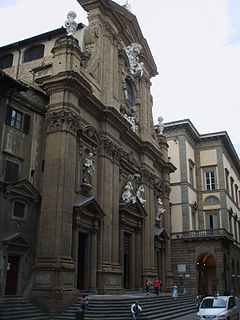
Palazzo Mozzi or Palazzo de' Mozzi is an early Renaissance palace, located at the end of the Piazza de' Mozzi that emerges from Ponte alle Grazie and leads straight to the palace where via San Niccolò becomes via de' Bardi in the Quartiere of Santo Spirito in the Oltrarno section of Florence, region of Tuscany, Italy. The 13th-century palace housed the gallery of the highly successful antiquarian Stefano Bardini, of which the remnants were left to the commune, where they assembled the Museo Bardini or Mozzi Bardini, displaying Florentine art and artifacts up to the early Renaissance. The gardens elaborated against the hillside behind the palace were added mainly by Bardini.
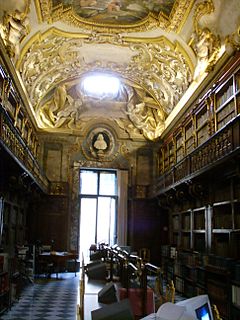
The Biblioteca Riccardiana is a library in Florence, Italy. The library is located in the Palazzo Medici Riccardi.
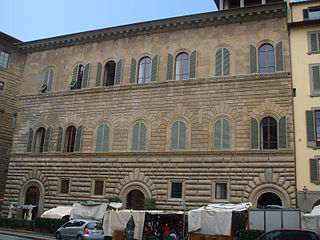
Palazzo Gondi is a palace in Florence, Italy, located a block from Piazza della Signoria. It was built in 1490 under design by Giuliano da Sangallo, who was inspired by other major works of stately buildings in the city, such as Palazzo Medici and Palazzo Strozzi. Among the elements borrowed from these earlier works are the cube-shape set around a central courtyard, the ashlar sloping on each of three floors, and the arched windows.

Palazzo Uguccioni is a Renaissance palace on the Piazza della Signoria in Florence, central Italy.

The Palazzo Minerbetti is an urban palace building located on Via de Tornabuoni #3 at the corner with Via del Parione, which edges into the Piazza Santa Trinita, Florence, in central Florence, region of Tuscany, Italy.

The Palazzo Nonfinito is a Mannerist-style palace located on Via del Proconsolo #12, in central Florence, region of Tuscany, Italy. Begun in 1593 using designs by the architect Bernardo Buontalenti, only the first floor was completed, and additional construction was added later by different architects. The Palace is presently the home of the Anthropology and Ethnology section of the Museum of Natural History of Florence.
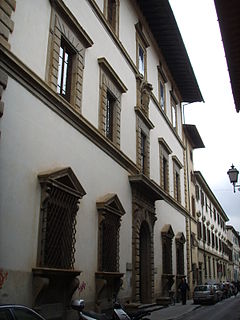
The Palazzo Giugni, also called the Palazzo Firenzuola, is a late-Renaissance or Mannerist architecture palace designed by Bartolomeo Ammanati, and located on Via degli Alfani #48 in the quartiere San Giovanni of Florence, region of Tuscany, Italy. It is located down the street from the Brunelleschi's church of Santa Maria degli Angeli.

The Palazzo Panciatichi is a Renaissance palace located on Via Camillo Cavour 2 in the quartiere of San Giovanni, Florence, region of Tuscany, Italy. A different Palazzo Panciatichi-Ximenes or Ximenes-da Sangallo is located at Borgo Pinti 68, corner of via Giusti, in Florence.
The Palazzo Orlandini del Beccuto, also known as Palazzo Gondi di Francia is a palace located with entrance on Via de' Pecori #6-8 in central Florence, region of Tuscany Italy.

The Palazzo Nasi, also known as the Palazzo Torrigiani or Palazzo Scarlatti, is a palace located at Piazza de' Mozzi 4, down the street where the Ponte alle Grazie enters the Oltrarno, in Florence, Tuscany, Italy. Another Palazzo Torrigiani Del Nero, with a Mannerist or late-Renaissance-style facade stands closer to the river. Both palaces also once belonged to the Nasi. The palace is a few steps from the Palazzo Mozzi.
The Palazzo Bartoli Corbini, also known as Palazzo Naldini or Pestellini is a palace located on Via Cavour #8 in central Florence, region of Tuscany Italy.
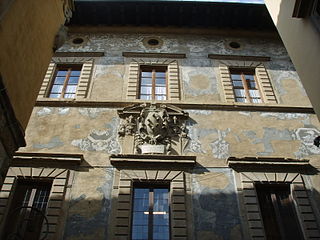
The Palazzo Ramirez de Montalvo, also known as Palazzo Matteucci is a palace located on Borgo degli Albizi #26 in central Florence, region of Tuscany Italy.
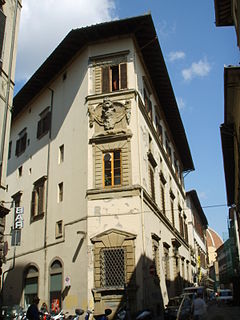
The Palazzo Mondragone, also known as Palazzo Mandragone, Ambron(n), Ricasoli di Meleto, or Peyron, is a palace located on Via del Giglio #4r-8r in central Florence, region of Tuscany Italy.
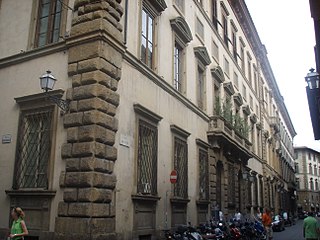
The Palazzo Pucci is a palace located at Via dei Pucci #4 in central Florence in the region of Tuscany, Italy. The façade of the palace spans from Via dei Servi to Via Ricasoli.
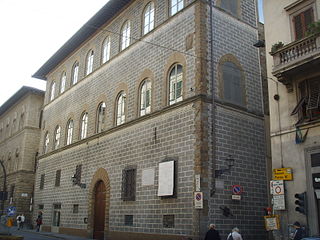
The Palazzo Busini Bardi is a palace located on Via dei Benci #5 in central Florence, Tuscany, Italy. It is in front of the Museo Horne.
The Palazzo Vecchietti is a Renaissance architecture palace located on Via degli Strozzi number 4, near Piazza della Repubblica in the quartieri of Santa Maria Novella, city of Florence, region of Tuscany, Italy.

Porta a Pinti was a former gate in the walls of Florence, region of Tuscany, Italy. The gate was also called Porta Fiesolana, of de Penitenti, which was shortened and corrupted to give name to the gate and the neighborhood, Borgo Pinti. Individuals returning to church, called convertiti or penitenti, lived in this neighborhood. It was destroyed in 1865 during the creation of the Viale di Circonvallazione, which removed most of the walls of Florence.
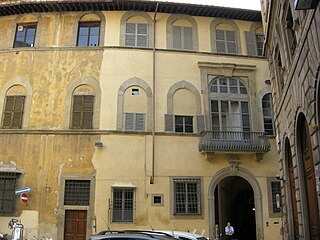
The Palazzo or Casa Martelli was a residential palace, and since 2009, a civic museum displaying in situ the remains of the original family's valuable art collection, as well as its frescoed rooms. The palace is located on Via Ferdinando Zannetti 8 near the corner with Via Cerretani in central Florence, region of Tuscany, Italy.

The "workshop" of Pietro Bazzanti and Son is an historic landmark in Florence, art and culture heritage of the city. It took part in the role of "Fine Arts Trader" at the National Exposition of 1861 in Florence with several marble sculptures and various other works. The Bazzanti Marble Studio won the medal for the category "sculpture".

The two fontane dei mostri marini are located in the Santissima Annunziata plaza in Florence.



